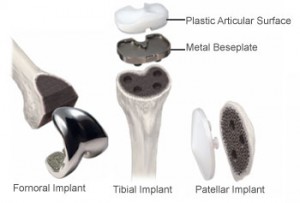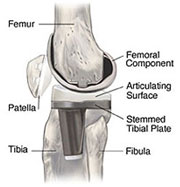Components of a total knee replacement
A total knee replacement prosthesis has four components: femoral component (made of metal) which is fixed to the cut surface of the femur (thigh bone), tibial component (made of metallic tray) which is fixed on the cut surface of the tibia (leg bone), a polyethylene liner (made of plastic) which is interposed between the femoral and tibial component and acts as an articulation, and a patellar component (made of plastic) which is fixed on the cut surface of the patella (knee cap). These components are usually fixed to bone using bone cement (polymethyl methacrylate).
What are the different types of knee replacements available?
Knee replacements are classified in various ways giving rise to different terminologies which can be confusing at times.
For the purposes of ease of description the knee joint is divided into three compartments – the medial (inside part of the knee) and lateral (outside part) and the patello-femoral compartment (between the knee cap and the thigh bone). When all the three compartments are replaced with artificial components then it is termed as total knee replacement. When only one compartment is replaced it is termed as unicompartmental knee replacement (sometimes called as “half knee replacement”).
A fixed bearing knee replacement (conventional knee replacement) means the polyethylene insert (plastic liner between the two metallic surfaces) is fixed inside the tibial tray. A mobile bearing knee (rotating platform knee) implies that the polyethylene (plastic) liner is not fixed but is free to rotate on a smooth tibial tray. A high flex knee is one where the femoral component is designed to achieve greater degree of knee flexion (bending). An all-poly knee is one where the there is no metallic tibial tray but the polyethylene liner is directly cemented on to the tibial cut surface.
Fixed bearing TKR All poly TKR Rotating platform TKR Unicompartmental knee


